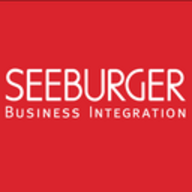

Find out what your peers are saying about IBM, Salesforce, Oracle and others in Enterprise Service Bus (ESB).
The support provided by SEEBURGER is excellent.
SEEBURGER Business Integration Suite is a very stable product, and I haven't noticed any significant drawbacks.
Acquiring training documents on a public domain for SEEBURGER is challenging.
It comes pre-loaded with solutions, meaning it is ready to use without requiring significant development.


With SEEBURGER’s experienced team behind you, and SEEBURGER BIS as the foundation of your hybrid integration strategy, you’re prepared for whatever comes your way – even as your business gains complexity and integration requirements increase.
SEEBURGER Business Integration Suite (BIS) is a unified, agile, secure and scalable platform that solves integration challenges across your business and ecosystem, so that you can make valuable connections between clouds, applications and people.
Our platform provides integration across all scenarios, including B2B/EDI, MFT, API and ERP on-premises, in the cloud and hybrid, in addition to expert support that is unmatched in the industry for your simplest to your most complex integrations.
Your APIs are likely multiplying quickly, and if you’re looking for a solution to manage, secure and scale them properly, you get all of the benefits and less of the hassle with our API Management toolkit.
Bring us your toughest B2B/EDI challenges. We help with difficult onboarding and partner connections, and will save you time and effort to complete complex projects. We make B2B easy with pre-packaged, re-usable content and automation capability, so your team can make the connection, and move on to the next mission.
Simplify your workload with our iPaaS solution. SEEBURGER iPaaS enables your team to save man-hours connecting data, applications and systems, by letting us handle all the time-consuming platform operations. We cover maintenance, updates, security, scalability and more.
Did you know that without managed file transfer (MFT), your company is at greater risk for a data breach? It’s as simple, and as dangerous, as that. The security and control you get with our centralized, easy-to-use solution ensures less risk for the company, and more sleep at night for you.
Our customers say it best! Check out our reviews you’ll see that SEEBURGER’s rock-solid, built-from-the-ground-up platform, is combined with an expert team, and stellar service. We power your connections, future-proof your vision and give you a competitive edge.
We monitor all Enterprise Service Bus (ESB) reviews to prevent fraudulent reviews and keep review quality high. We do not post reviews by company employees or direct competitors. We validate each review for authenticity via cross-reference with LinkedIn, and personal follow-up with the reviewer when necessary.